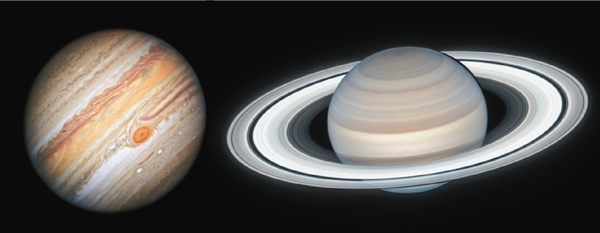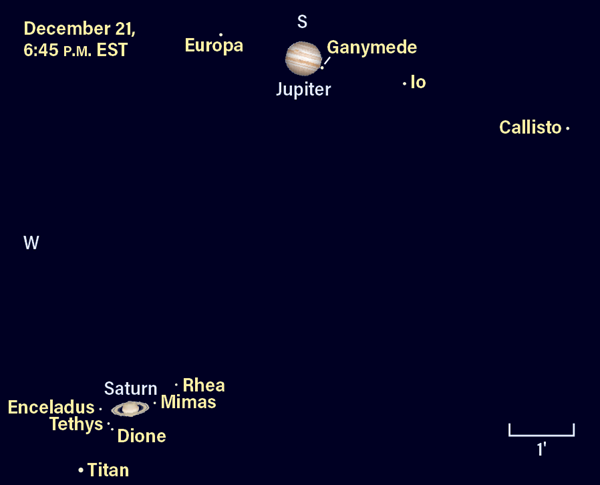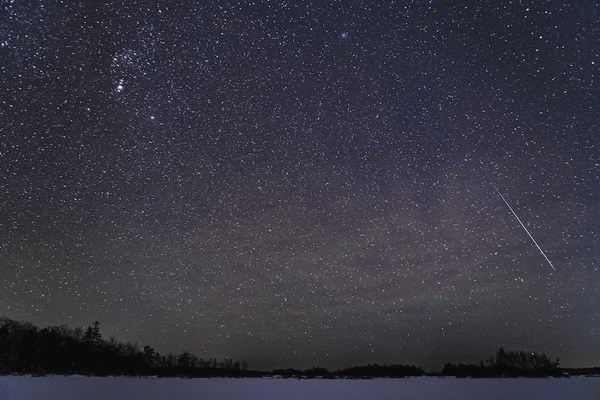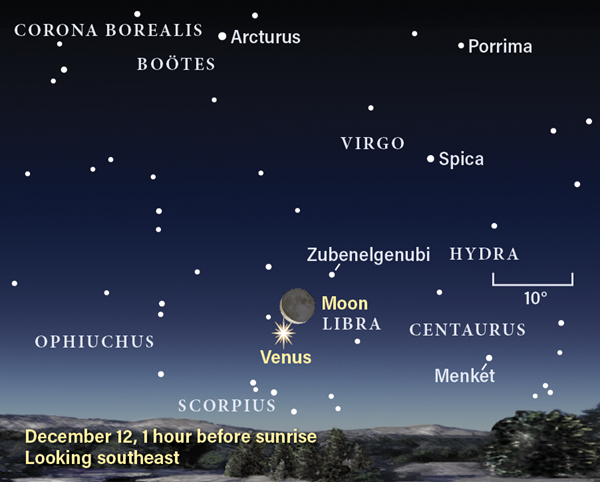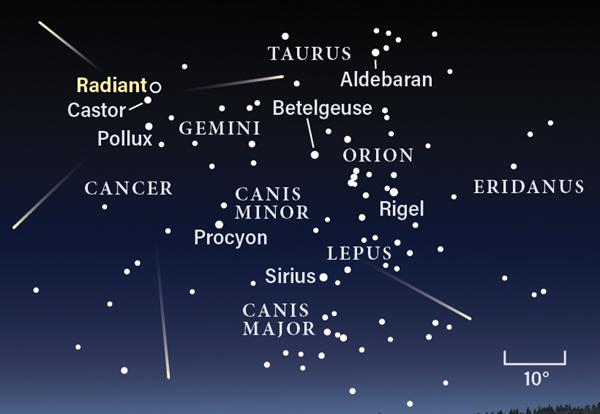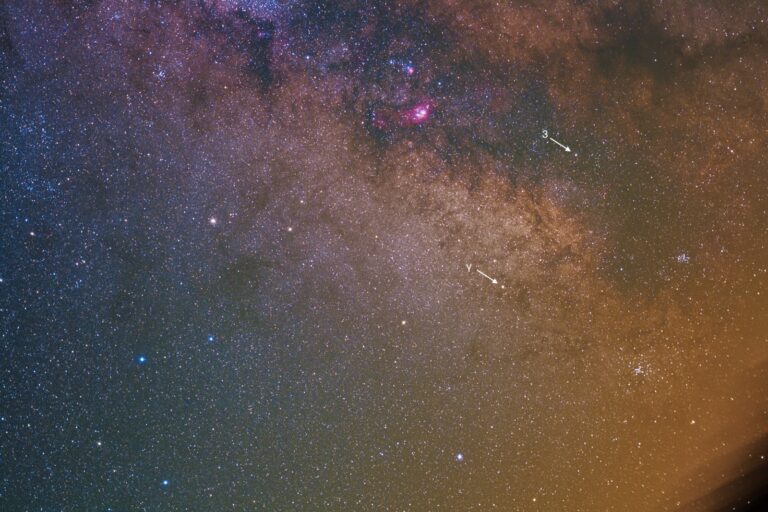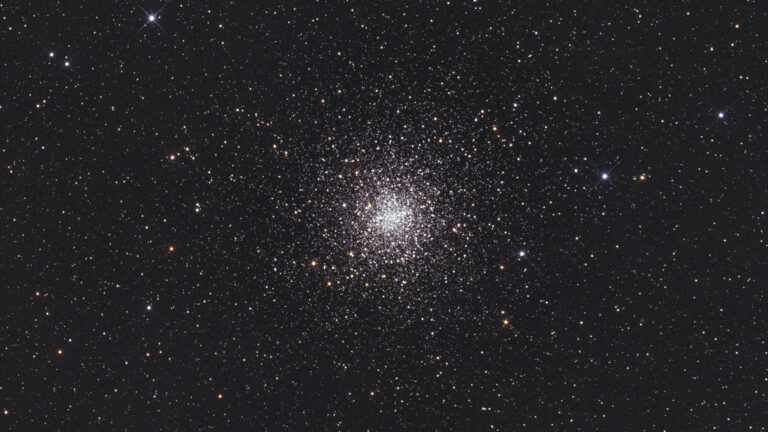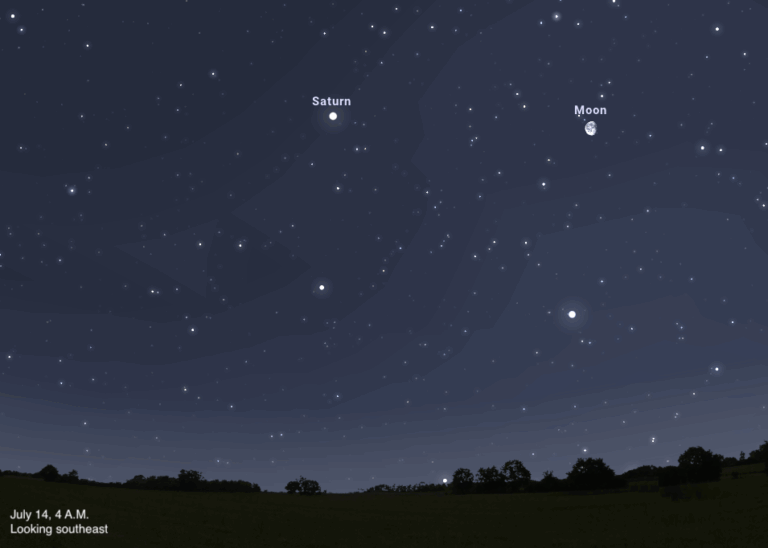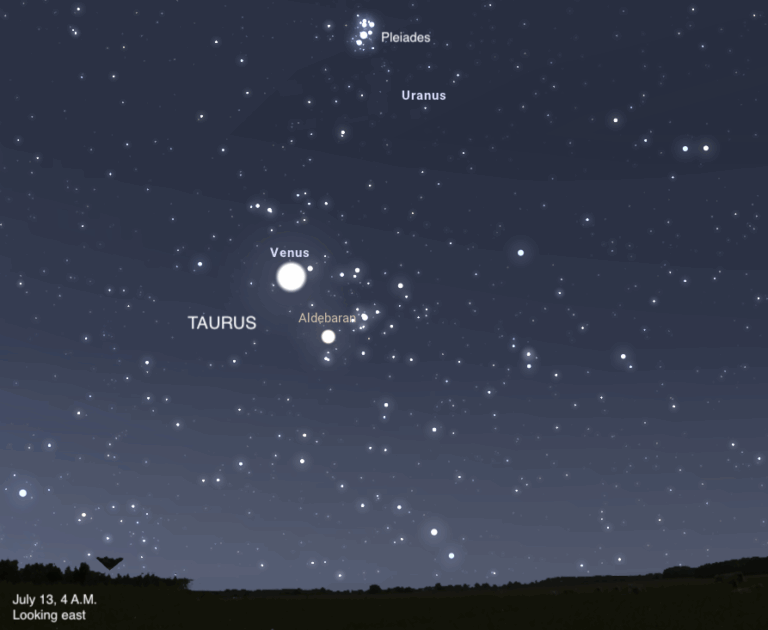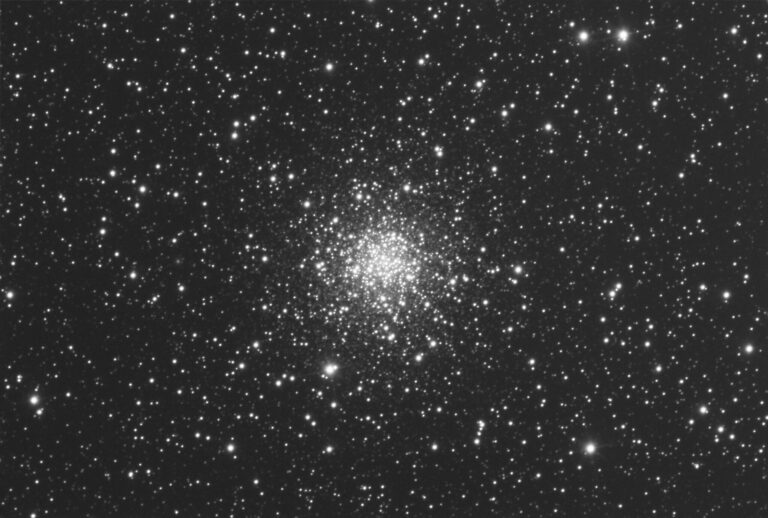Key Takeaways:
We start our nightly tour of the planets with Jupiter and Saturn. The two bright planets have regaled evening sky observers for the last half of the year. On December 1, they appear 2.1° apart, low in the southwest soon after sunset and about 20° high by 6 P.M. local time.
Jupiter shines as a brilliant magnitude –2.0 jewel, while Saturn’s fairer complexion comes in at magnitude 0.6. They set by 8:30 P.M. local time in the first week of December, leaving little time to view them. But drama builds as they approach a stunning close conjunction December 21.
You’ll find the pair a mere Moon’s breadth apart on December 16. And, as if offering the perfect comparison tool, a waxing crescent Moon sits 5° below them. Catch the trio low in the southwest 30 minutes or so after sunset. The shadowed portion of the Moon is illuminated by earthshine, making the whole satellite visible against the deepening twilight. The Moon sets shortly after 7:20 P.M. local time and the planets follow 20 minutes later.
During this conjunction, observers in the eastern half of the U.S. will see Ganymede begin to transit Jupiter starting at 7:04 P.M. EST. The transit takes 3.5 hours, so observers in the western U.S. will see the second half, as well as catch the moment Ganymede’s large shadow appears on the jovian cloud tops at 9:40 P.M. EST.
Saturn is surrounded by its slew of moons, including four standing west of the rings: Enceladus, Tethys, Dione and Titan. The latter is 1′ from the planet. Rhea and Mimas are east of the rings.
Moving eastward along the ecliptic, the next planet we find is Neptune, located in Aquarius the Water-bearer. Center 4th-magnitude Phi (ϕ) Aquarii in binoculars, then look for the ice giant roughly 0.75° (1.5 Moon-widths) northeast of the star. You’ll find the planet near the same spot during the first week of December, as Neptune reached its stationary point November 29 and is just beginning its direct motion eastward once again, moving at a snail’s pace at first.
A pair of 7×50 binoculars will catch the magnitude 7.9 planet, and you can watch it move to a distance of 1° from Phi during the month. There’s a nice pair of 6th-magnitude stars that form a triangle with Phi; they’re located twice as far from the star as Neptune, also to the northeast. Neptune is heading toward a point midway between this pair of stars. A telescope using medium magnification reveals its bluish disk, spanning 2″.
On December 20, Neptune stands just over 4° north of a waxing crescent Moon. The planet sets in the hour before midnight by late December.
Mars crosses from south to north of the ecliptic December 2 (its ascending node). It becomes progressively more favorable for Northern Hemisphere observers as its altitude increases when it is due south, meaning the planet’s light passes through less of Earth’s atmosphere. On December 1 at the start of nautical twilight (with the Sun 12° below the horizon), Mars is 40° high in the southeast. On December 31 at the same time, Mars already stands 60° high and its light passes through 16 percent less atmosphere than on the 1st.
However, the Red Planet’s distance is increasing from Earth at the same time, resulting in a diminishing diameter. Mars shrinks from 14.6″ to 10.5″ by the end of the month. Additionally, its gibbous phase becomes more pronounced throughout the month, slimming from 92 percent lit on December 1 to 89 percent by the 31st. Mars observers take this in their stride — there’s no other choice! The key to observing Mars now is to view it whenever you can under good conditions.
If you observe Mars each evening at 10 P.M. EST, the following features will be visible: December 1 starts the month with the Tharsis Ridge volcanoes facing Earth and Valles Marineris rotating off the limb. On December 7, Valles Marineris takes center stage and the high volcanoes rise over the terminator during the next hour. By December 14, it’s Sinus Sabaeus’ turn, and Syrtis Major is disappearing off the disk. December 21 finds Syrtis Major and the bright Hellas basin central on the disk. By December 28, Mare Cimmerium’s dark swath is on view.
You can catch many of these features later in the night on different dates. Because Mars rotates in 24 hours 37 minutes, features visible centrally on the disk at 9 P.M. on December 1 will be visible a week later by viewing three to four hours later (i.e., midnight to 1 A.M.). For example, if you are chasing Syrtis Major across the disk December 21 at 9 P.M., you can also find it on December 28 after midnight.
Uranus lies in Aries the Ram and is an easy binocular object at magnitude 5.7. Yet,
it’s deceptively hard to spot because it lies in a sparse region of the sky. The planet stands high in the east after sunset and sets during the early morning hours.
Use Hamal, the brightest star in Aries, and Menkar, southeast of it in Cetus the Whale, to create an imaginary triangle with Mars, which lies west of the pair. A line from Mars through the gap between Aldebaran and the Pleiades in Taurus helps you define the plane of the ecliptic. Uranus lies along this line, just west of a line between Hamal and Menkar. The Moon also helps the evening of December 24, when Uranus stands 3.6° northwest of our satellite. Don’t confuse it with a star of similar brightness, 19 Arietis, which lies a few degrees northwest of the planet. A telescope easily reveals Uranus’ planetary nature via its light bluish-green 4″-wide disk.
Venus rises soon after 5 A.M. local time in early December and stands about 10° high in the southeastern sky an hour later. It comes within 1.3° of Libra’s brightest star, Zubenelgenubi, and continues to reduce its elongation from the Sun all month. By December 31, the planet rises about 6 A.M. local time, just 90 minutes before the Sun.
A fine crescent Moon lies about 4° northwest of Venus on December 12 (closer for those in the western U.S.), providing a beautiful predawn view. The Moon occults Venus during daylight hours from locations along the western U.S. coastal states, Alaska, and Hawaii.
By late December, Venus crosses into Scorpius and is less than 12′ from Beta (β) Scorpii in the predawn sky December 18. Venus reaches Ophiuchus December 22 and stands 5.8° north of Antares. Throughout the month, the planet’s gibbous phase will grow from 89 percent to 94 percent lit.
Mercury reaches aphelion and superior conjunction in the same week this month. It has the most eccentric orbit of all the planets, and aphelion occurs December 16, when it lies nearly 43.4 million miles from the Sun. It reaches superior conjunction December 20 and will reappear in the evening skies next year.
A total eclipse of the Sun occurs December 14 for locations in Chile and Argentina. Compared to 2019, the track is farther south and totality occurs near midday, with the Sun high in the sky. The longest duration of the eclipse occurs over land and lasts 2 minutes 9 seconds.
Rising Moon: A striking glance
An easy find in the equatorial region of the Moon is the unusual crater doublet Messier. It was named in honor of the 18th-century comet hunter because of the long, cometlike tail of material spreading westward across a darker background.
The origin of the barely diverging white rays puzzled astronomers for centuries. Their theories were bizarre and completely off base, which showed they didn’t get the irony of the progenitor: a comet impact! In 1978, Don Gault and John Wedekind plainly showed how Messier was made: A fast-moving projectile whacked the Moon from the east at a low grazing angle. It skipped once, spraying debris forward as it dunked and exploded. An icy comet nucleus might have done it, although a rock is more likely.
At NASA’s Ames Vertical Gun Range in Mountain View, California, the scientists shot small pellets at mind-blowing speeds of 15,000 mph toward different targets. They showed how the resulting craters and spray change shape as the firing angle is adjusted. What may have brought the biggest smile to their faces was that they could create a double crater with only one pellet. There was no need to invoke the extra coincidence of a double impactor, although we now know those do exist in the form of contact binary asteroids.
The first observing window for the doublet is already closing on the 2nd as the Sun sets beyond Messier. When sunrise returns on the 18th, the low angle exaggerates the topography; power up to 100x or more to see that the craters are distinctly out-of-round compared to others nearby. To see the rays stretching westward, wait another night or two, when the higher Sun emphasizes albedo (brightness) differences.
Meteor Watch: A moonless show
One of the richest meteor showers of the year, the Geminids peak the evening of December 13 with no interference from the Moon. The best time to view is after 11 P.M. local time on the 13th through early morning on the 14th. By late evening, the radiant is high in the eastern sky and is overhead for North American viewers by 1 A.M. local time. The predicted zenithal hourly rate of 100-plus meteors per hour might be achieved under ideal conditions. However, this rate includes faint meteors. The Geminids do provide many bright meteors, but those rates are much lower. The shower is active between December 4 and 17.
The Ursid meteor shower, active from December 17 to 26, peaks the morning of December 22, partially affected by the First Quarter Moon.
Comet Search: Fast-moving target
In the same way that planet Mars glides quickly across the background stars after opposition, so does Comet 88P/Howell. Currently dimming through 9th to 10th magnitude, Howell is more than 15° high at the end of astronomical twilight, so we see it in a dark sky. The Sun sets so early that you can’t wait until midevening to search it out.
Deep-sky observers familiar with Capricornus will know its globular cluster M30. In a small telescope, the round fuzz is easy to spot compared with the fainter Howell. But just to the north in Aquarius lies 9th-magnitude M72, a much better match for the comet. Take a really close look for differences in size, shape, texture, and brightness profile. They’re going to be quite similar!
A dark-sky window opens for one hour December 3, widening each following night. On the 21st, Howell skims southeast of Deneb Algedi (Delta [δ] Capricorni), but the Moon’s light has been interfering with the view since the 17th.
Locating Asteroids: Pebble in the jar
Unlike the splashy winter constellations barely rising, the watery constellations of Aquarius, Capricornus, and Piscis Austrinus are relatively dim. The celestial lighthouse Fomalhaut guides us across the southern sky in early evening, shining at magnitude 1.2. Sail 13° due north of the pale yellow luminary to arrive at 1 Ceres, just below Delta (δ) Aquarii. A small scope will capture its magnitude 9 glow from the city or suburbs.
The dwarf planet’s journey this month takes it past many stars of similar brightness in the outer halo of the Milky Way. To be sure you have positively identified the ruler of the asteroid belt, follow its motion across two or more nights. Ceres slides through the corner of a quadrilateral from December 7 to 9 and a slanted pair of stars on the 13th.
Sporting a diameter of 600 miles, Ceres appears 0.4″ in diameter. An 8-inch scope can’t quite differentiate this from a star by its size, but if the night is calm and seeing steady, crank the power to the max and you might notice that Ceres looks “flat” compared to a star of similar brightness.
Another solar system royal, Neptune, hovers a few more degrees to the northeast — make sure to also check it out.

